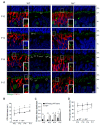Murine Retina Outer Plexiform Layer Development and Transcriptome Analysis of Pre-Synapses in Photoreceptors
- PMID: 39337887
- PMCID: PMC11433150
- DOI: 10.3390/life14091103
Murine Retina Outer Plexiform Layer Development and Transcriptome Analysis of Pre-Synapses in Photoreceptors
Abstract
Photoreceptors in the mammalian retina convert light signals into electrical and molecular signals through phototransduction and transfer the visual inputs to second-order neurons via specialized ribbon synapses. Two kinds of photoreceptors, rods and cones, possess distinct morphology and function. Currently, we have limited knowledge about rod versus (vs.) cone synapse development and the associated genes. The transcription factor neural retina leucine zipper (NRL) determines the rod vs. cone photoreceptor cell fate and is critical for rod differentiation. Nrl knockout mice fail to form rods, generating all cone or S-cone-like (SCL) photoreceptors in the retina, whereas ectopic expression of Nrl using a cone-rod homeobox (Crx) promoter (CrxpNrl) forms all rods. Here, we examined rod and cone pre-synapse development, including axonal elongation, terminal shaping, and synaptic lamination in the outer plexiform layer (OPL) in the presence or absence of Nrl. We show that NRL loss and knockdown result in delayed OPL maturation and plasticity with aberrant dendrites of bipolar neurons. The integrated analyses of the transcriptome in developing rods and SCLs with NRL CUT&RUN and synaptic gene ontology analyses identified G protein subunit beta (Gnb) 1 and p21 (RAC1) activated kinase 5 (Pak5 or Pak7) transcripts were upregulated in developing rods and down-regulated in developing SCLs. Notably, Gnb1 and Gnb5 are rod dominant, and Gnb3 is enriched in cones. NRL binds to the genes of Gnb1, Gnb3, and Gnb5. NRL also regulates pre-synapse ribbon genes, and their expression is altered in rods and SCLs. Our study of histological and gene analyses provides new insights into the morphogenesis of photoreceptor pre-synapse development and regulation of associated genes in the developing retina.
Keywords: gene expression; neural retina leucine zipper; pedicle; photoreceptor synapse; retina outer plexiform layer; spherule; transcriptional regulation.
Conflict of interest statement
The authors declare no competing interests.
Figures







Similar articles
-
Developmental genome-wide occupancy analysis of bZIP transcription factor NRL uncovers the role of c-Jun in early differentiation of rod photoreceptors in the mammalian retina.Hum Mol Genet. 2022 Nov 10;31(22):3914-3933. doi: 10.1093/hmg/ddac143. Hum Mol Genet. 2022. PMID: 35776116 Free PMC article.
-
Transformation of cone precursors to functional rod photoreceptors by bZIP transcription factor NRL.Proc Natl Acad Sci U S A. 2007 Jan 30;104(5):1679-84. doi: 10.1073/pnas.0605934104. Epub 2007 Jan 22. Proc Natl Acad Sci U S A. 2007. PMID: 17242361 Free PMC article.
-
Cone-rod homeobox CRX controls presynaptic active zone formation in photoreceptors of mammalian retina.Hum Mol Genet. 2018 Oct 15;27(20):3555-3567. doi: 10.1093/hmg/ddy272. Hum Mol Genet. 2018. PMID: 30084954 Free PMC article.
-
The neuronal organization of the outer plexiform layer of the primate retina.Int Rev Cytol. 1984;86:285-320. doi: 10.1016/s0074-7696(08)60181-3. Int Rev Cytol. 1984. PMID: 6368448 Review.
-
Tuning outer segment Ca2+ homeostasis to phototransduction in rods and cones.Adv Exp Med Biol. 2002;514:179-203. doi: 10.1007/978-1-4615-0121-3_11. Adv Exp Med Biol. 2002. PMID: 12596922 Review.
References
LinkOut - more resources
Full Text Sources
Research Materials
Miscellaneous

